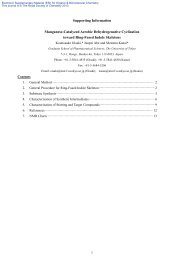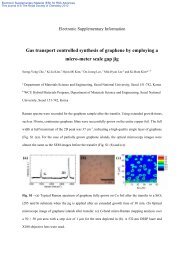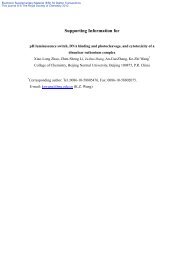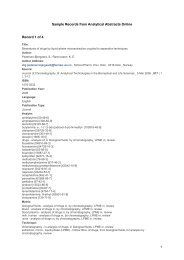Supporting Information Hetero-epitaxy of Anisotropic ...
Supporting Information Hetero-epitaxy of Anisotropic ...
Supporting Information Hetero-epitaxy of Anisotropic ...
You also want an ePaper? Increase the reach of your titles
YUMPU automatically turns print PDFs into web optimized ePapers that Google loves.
Electronic Supplementary Material (ESI) for Chemical Communications<br />
This journal is © The Royal Society <strong>of</strong> Chemistry 2013<br />
Experimental details<br />
Materials<br />
Polycaprolactone (PCL, M n 70 000 ~ 90 000 g mol -1 ) was obtained from Sigma-Aldrich (Shanghai)<br />
Trading Company. Chlor<strong>of</strong>orm was purchased from Beijing Chemical Works, which was purified by<br />
5 molecular sieve dehydration before use. Other organic reagents, glass plates and glass tubes were<br />
bought from Beijing Chemical Works.<br />
Fabrication <strong>of</strong> composite PCL/PTFE films<br />
The glass plates or glass tubes were first successively cleaned with pure water, hot acetone, hot<br />
concentrated sulfuric acid-hydrogen peroxide solution (concentrated sulfuric acid/hydrogen peroxide =<br />
10 2:1), pure water, and pure ethanol.<br />
To prepare well aligned thin films <strong>of</strong> highly aligned PTFE, the friction-deposition technique was<br />
utilized. Before rubbing, the friction surface <strong>of</strong> PTFE rod was fully polished by 1200 mesh sand paper.<br />
To rub a glass plate, a PTFE rod with the diameter <strong>of</strong> 20 mm and the length <strong>of</strong> 5 cm was used. The<br />
deposition was performed at a velocity <strong>of</strong> 10 mm/s, a temperature <strong>of</strong> 280 °C, and an applied pressure<br />
15 <strong>of</strong> 0.5 MPa. To rub a glass tube (diameter 8 mm, length 4 cm), the home-made PTFE rod (a quarter <strong>of</strong><br />
PTFE rod with the length 8 cm) with the same curvature radius <strong>of</strong> 8 mm as the glass tube was used.<br />
The rubbing was performed at a velocity <strong>of</strong> 10 mm/s, a temperature <strong>of</strong> 280 °C, and an applied pressure<br />
<strong>of</strong> around 0.5 MPa with the home-made PTFE rod at a tilt angle <strong>of</strong> 2º. It should be noted that the<br />
temperature and pressure could not be controlled as well as on flat surface when rubbing inside the<br />
20 tube. After self-cooling into room temperature, the glass substrates or glass tubes with aligned PTFE<br />
were immersed into the PCL solution (about 0.01 g mL -1 in chlor<strong>of</strong>orm) for 1 minute and then pulled<br />
out. After evaporation <strong>of</strong> solvent, the thin anisotropic PCL films were formed on the oriented PTFE















